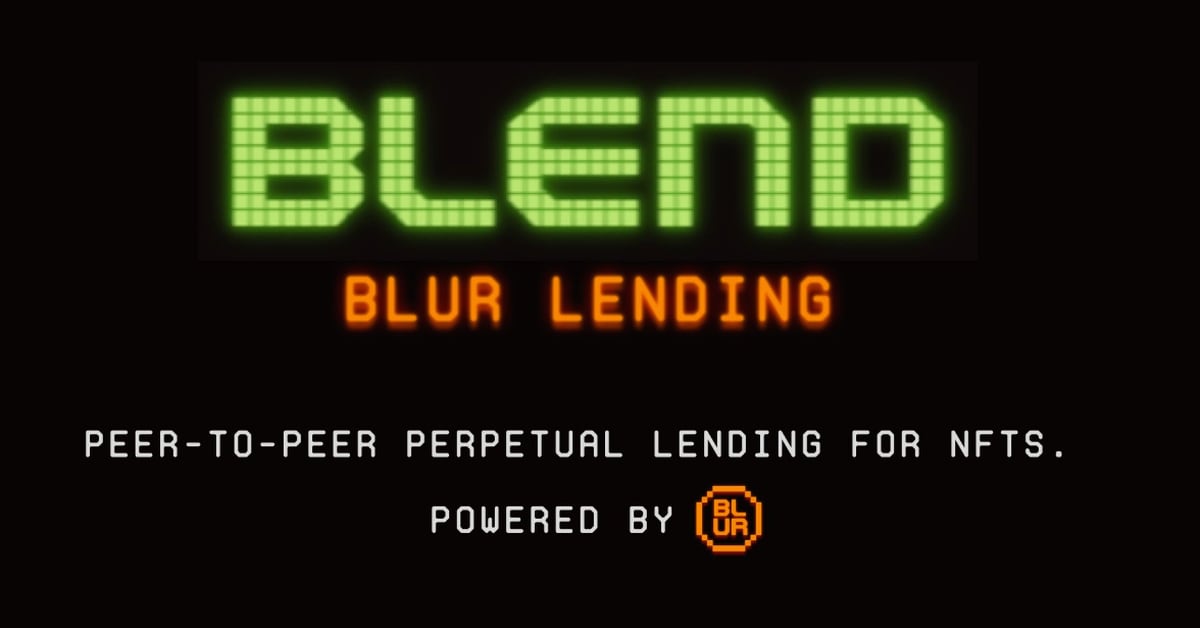NFT lending platform Blend sparks concerns over ecosystem liquidity

Pro-focused non-fungible token (NFT) marketplace Blur is making headlines again, this time for entering the NFT lending space. The move has raised questions about its wider market impact.
On Monday, Blur launched Blend, a peer-to-peer NFT lending platform that allows traders to rent out their NFTs to collectors who want to buy blue-chip NFTs with a small upfront payment. Holders hoping to earn some extra funds can set up NFTs, receive loan offers, and then transfer their token via an escrow smart contract to the tenant for a specified period of time – the equivalent of a digital pawn shop.
According to Blur, Blend aims to help introduce new buyers to its ecosystem by lowering fiscal barriers to entry for popular NFT collections. As a result, it helps drive liquidity into the larger NFT ecosystem by increasing the volume of traders and transactions.
It is possible that Blend has contributed to a short-term increase in the floor prices of some blue chip NFT pools, according to data from NFT marketplace OpenSea. Since May 1st, the date Blend launched, the floor price of the popular Bored Ape Yacht Club collection has increased from 47 ETH, or about $93,500, to about 50 ETH, or $99,400. In the case of Mutant Ape Yacht Club, the floor price increased from approximately 10.5 ETH, or $20,900, to 11 ETH, or $21,900.
While it looks like Blend could help push the NFT markets higher, it may not be a product that any amateur trader should be eager to “monkey” into. The danger is that NFT lending platforms like Blur allow collectors to buy tokens with funds they don’t have, creating liquidity risk when fundraising floors or cryptocurrency prices crumble.
Twitter user Carl_m101, founder of NFT collective Sky Scooters, shared a thread explaining some of the risks of Blend, where after a big price jump, a “margin call” the event may follow where traders sell their NFTs and as a result end up clearing the market.
“While systems like these are of course basic knowledge for experienced traders, they are new to most NFT traders who can now suddenly afford to buy the shiny profile picture (PFP) they’ve been dreaming of,” said Carl. “We will have a lot of inexperienced buyers going into projects they couldn’t afford before or taking out loans on their PFPs to buy more.”
While other platforms in the NFT space offer lending, the concern with Blend is that it is a product directly from Blur, one of the leading NFT marketplaces in terms of trading volume, according to data from Dune analytics. Considering the market share, the already avid users may be more likely to choose to lease NFTs instead of buying tokens at full price.
Not only could it hurt the market, but it could also hurt the original BLUR token. Pseudonymous Twitter user Bamboo, strategic manager of the NFT trader club Invite Only Lounge, said in a twitter thread that when the NFT market is affected by lenders on Blend, it will damage people’s BLUR holdings as well as negatively impact the larger crypto ecosystem.
“Blur uses game theory with its tokenomics and unique airdrop distribution mechanics,” said Bamboo. “But as game theorists, they must remember – increasing players’ payoffs at the expense of others is not Pareto-optimal.”
Although Blur is one of the first major NFT marketplaces to launch its own in-house lending platform, it is certainly not the first to introduce the concept of pawnshops.
PirateCode and Cryptobiosis, the pseudonymous co-founders of peer-to-peer NFT lending platform BendDAO, told CoinDesk that while NFT lending is generally beneficial to the market and can help bolster liquidity, some of Blend’s funding strategies raise concerns about whether its ” refinancing” process will actually keep lenders safe.
One issue they called out was the mechanism by which lenders can exit their positions. To do so, they would trigger a Dutch auction to find a new lender and refinance.
“The viability of the refinancing process introduced by Blend remains uncertain,” PirateCode and Cryptobiosos said. “In practice, refinancing only becomes relevant when the number of lenders exceeds that of borrowers.”
Another point of concern regarding Blend is the process of raising loans to purchase NFTs on the platform.
Jonathan Gabler, co-founder of peer-to-peer NFT lending platform NFTFi, told CoinDesk that while Blend’s initiative to help introduce liquidity to the market is innovative, it is also dangerous to encourage traders to take out LTV loans ) which is troublesome for highly volatile digital assets.
“Unchanged, the current incentive design is likely to lead to bad outcomes for borrowers such as mass defaults or liquidation of high-risk loans, wash NFTs into the hands of spot farmers, and consequently could lead to much higher market volatility,” Gabler said. “Existing peer-to-peer protocols tend to be more borrower-friendly and lead to healthier lending markets.”























